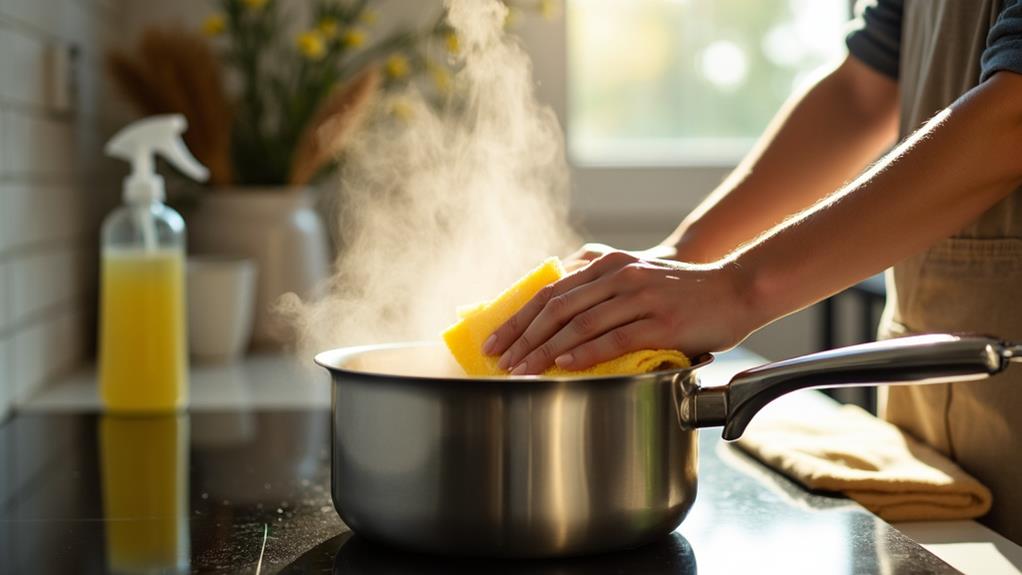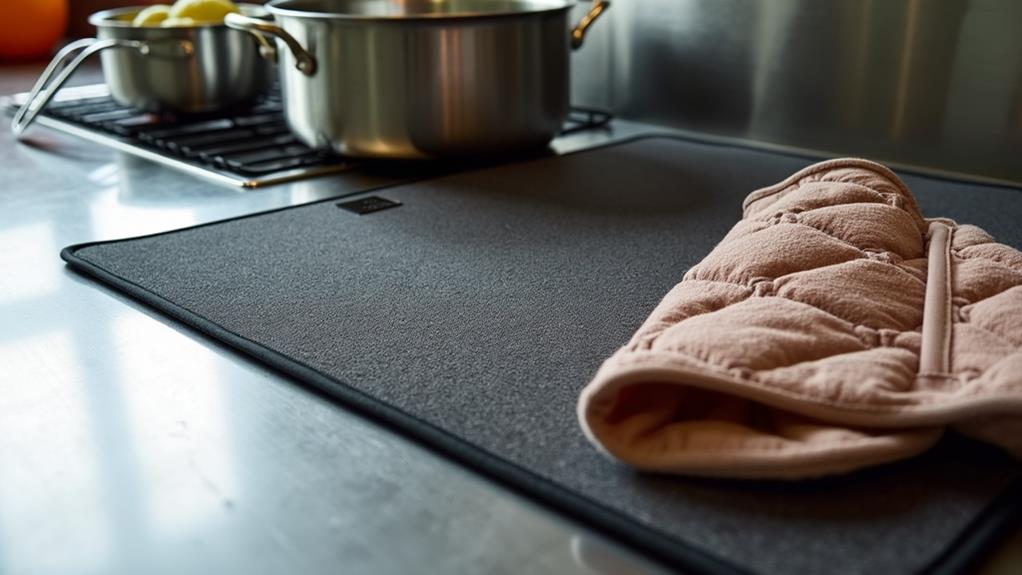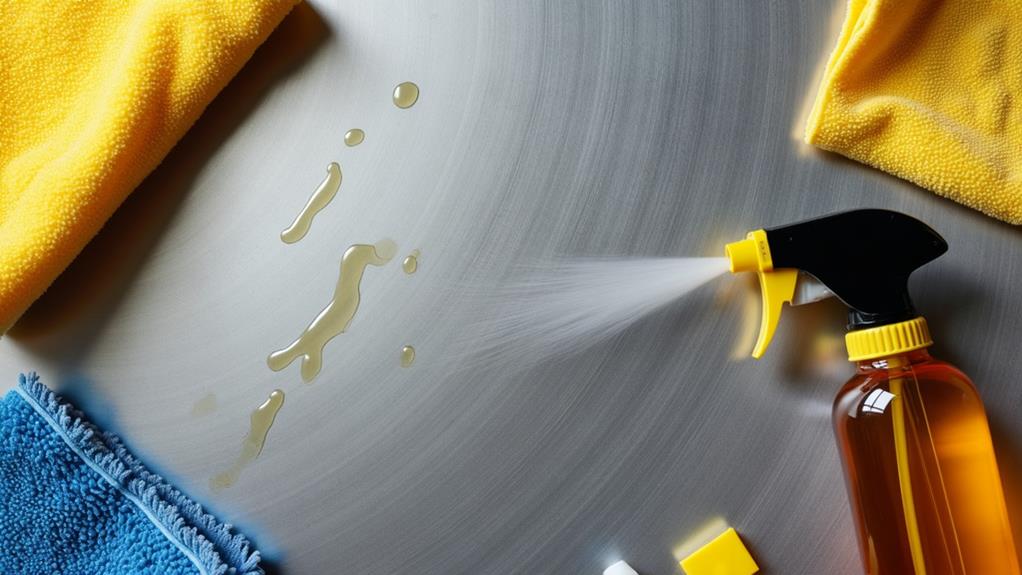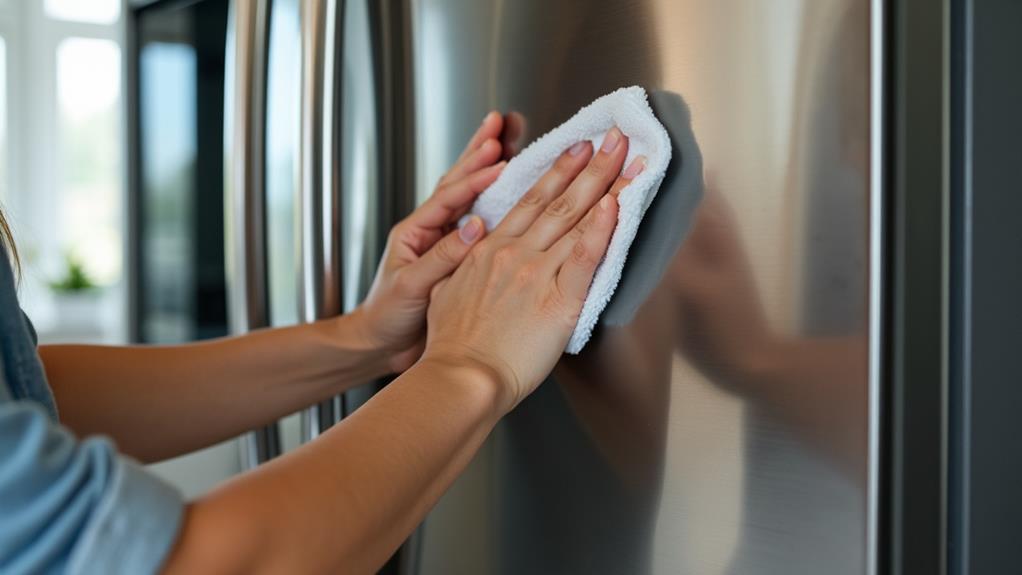Stainless Steel Care: What Not to Do
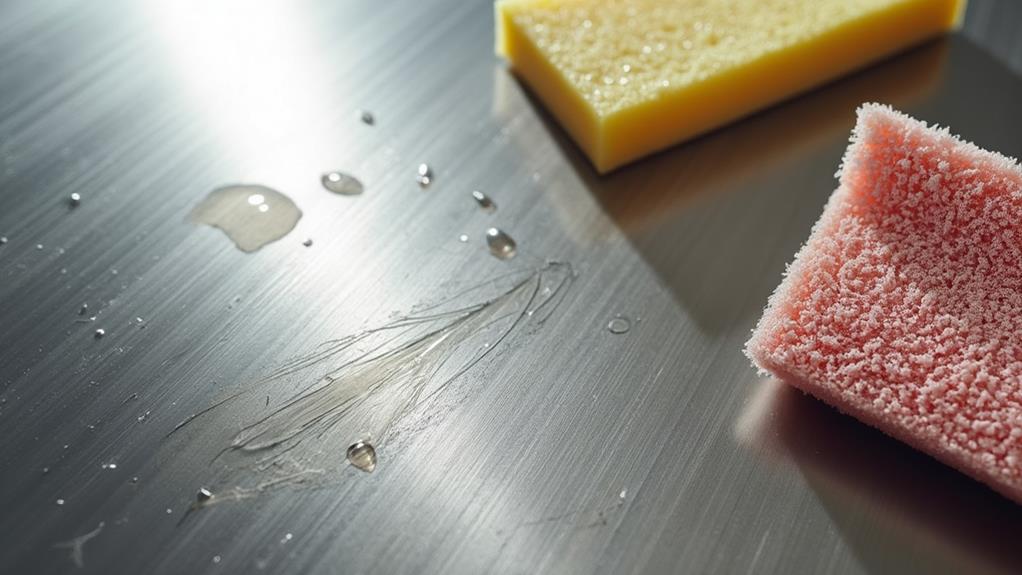
When caring for stainless steel, avoid abrasive cleaners and steel wool, which can scratch and ruin the finish. Skip bleach as it damages the protective layer, leading to rust. Don't ignore water spots; dry the surface immediately to keep its shine. Avoid using hard water to minimize mineral deposits, and always wipe spills right away to prevent staining and corrosion. Regular cleaning is crucial, so don't skip it. Finally, always follow manufacturer guidelines to prevent costly repairs. There's more to learn to guarantee your stainless steel stays pristine and lasting.
Using Abrasive Cleaners
Regarding maintaining stainless steel, steer clear of abrasive cleaners like scouring powders or steel wool. These rough materials can scratch the surface, leaving your stainless steel looking dull and worn. Instead, opt for non-abrasive alternatives. Microfiber cloths, gentle dish soap, and water are excellent choices that won't harm the finish. For tougher spots, try using a paste made from baking soda and water.
It's crucial to establish a regular cleaning frequency to keep your stainless steel looking its best. Aim to clean high-touch surfaces, such as kitchen appliances and sinks, at least once a week. This routine prevents the buildup of grime and fingerprints that can be harder to remove later.
When wiping down your stainless steel, always go with the grain to avoid streaks and maintain the material's natural shine. If you're dealing with stubborn stains, white vinegar can be a great non-abrasive alternative. Simply apply it with a soft cloth and rinse thoroughly. By incorporating these gentle methods and sticking to a consistent cleaning schedule, you'll preserve the sleek, polished look of your stainless steel items for years to come.
Applying Bleach
Although it might seem like a powerful cleaning agent, bleach should be used with caution on stainless steel surfaces. Bleach can be incredibly harsh and can damage the protective layer that gives stainless steel its rust-resistant properties. Once this layer is compromised, your stainless steel finishes can become prone to rust and corrosion, diminishing their appeal and functionality.
Instead of bleach, consider using bleach alternatives that are much gentler on stainless steel. For example, a mixture of mild dish soap and warm water can effectively clean without causing harm. White vinegar is another excellent option that not only cleans but also helps remove any lingering odors. Baking soda, when combined with water, forms a paste that can tackle tough stains without scratching the surface.
To maintain your stainless steel finishes, make sure to rinse thoroughly and dry the surface after cleaning. This helps prevent any potential residue from causing long-term damage. By opting for bleach alternatives, you'll protect your stainless steel items, ensuring they remain shiny and in excellent condition for many years to come. Remember, taking these small steps now can save you from bigger headaches down the line.
Ignoring Water Spots
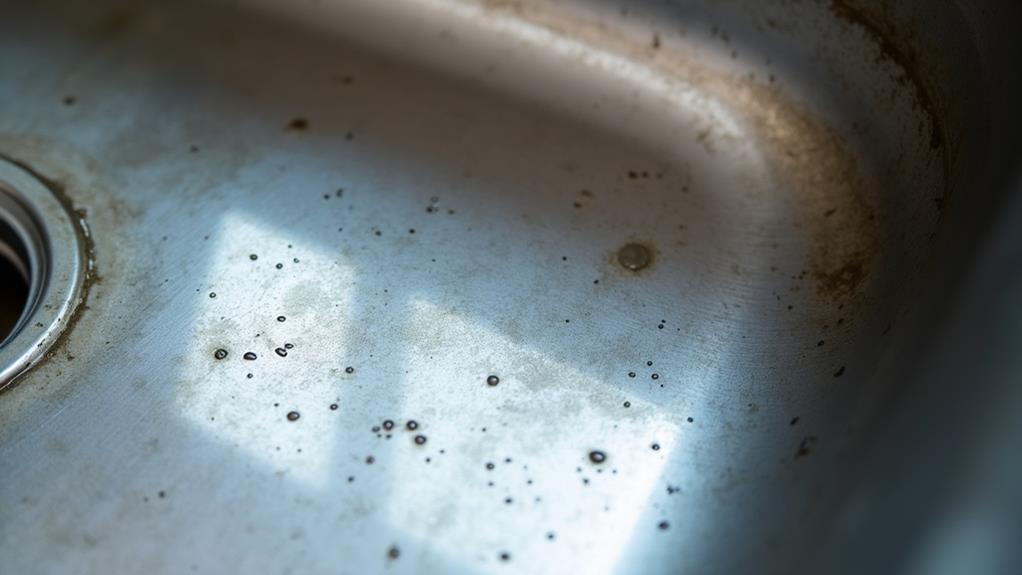
Water spots may seem harmless, but neglecting them can lead to more significant issues on your stainless steel surfaces. These annoying spots can transform your shiny surfaces into dull, unattractive ones. By ignoring them, you risk long-term damage that impacts both aesthetics and functionality. Fortunately, addressing water spots is straightforward if you know what to do.
Here are four key steps to keep in mind for water spot prevention:
- Wipe Immediately: Right after cleaning or using your stainless steel surfaces, wipe them dry with a soft cloth. This prevents water from evaporating and leaving spots behind.
- Effective Drying: After cleaning, make sure to dry the surface thoroughly. It's not just about removing visible water; even small amounts can cause spots if left unchecked.
- Use Distilled Water: Tap water often contains minerals that contribute to water spots. Using distilled water can minimize this risk and keep your surfaces spotless.
- Regular Maintenance: Routine cleaning and drying go a long way. Consistent care helps maintain the pristine look of your stainless steel, preventing water spots from forming in the initial place.
Using Steel Wool
When dealing with stainless steel care, one tool you should be cautious with is steel wool. While it might seem like a good idea for tough stains or grime, steel wool can actually do more harm than good. The abrasive nature of steel wool can scratch the surface of your stainless steel, leading to permanent damage and an unsightly appearance.
Instead of using steel wool, opt for safer steel wool alternatives. Microfiber cloths, soft sponges, or non-abrasive scrubbers are excellent choices. These options are gentle yet effective in maintaining your stainless steel surfaces without causing scratches. For tougher spots, consider using a paste made from baking soda and water; it's both gentle and effective.
Stainless steel maintenance doesn't have to be a chore. By avoiding steel wool, you're already taking a significant step toward preserving the appearance and longevity of your stainless steel items. Regular cleaning with mild soap and water, followed by drying with a soft cloth, will keep your stainless steel looking its best. Remember, the key to effective stainless steel maintenance is to choose the right tools and methods, ensuring your surfaces remain scratch-free and gleaming.
Letting Spills Sit
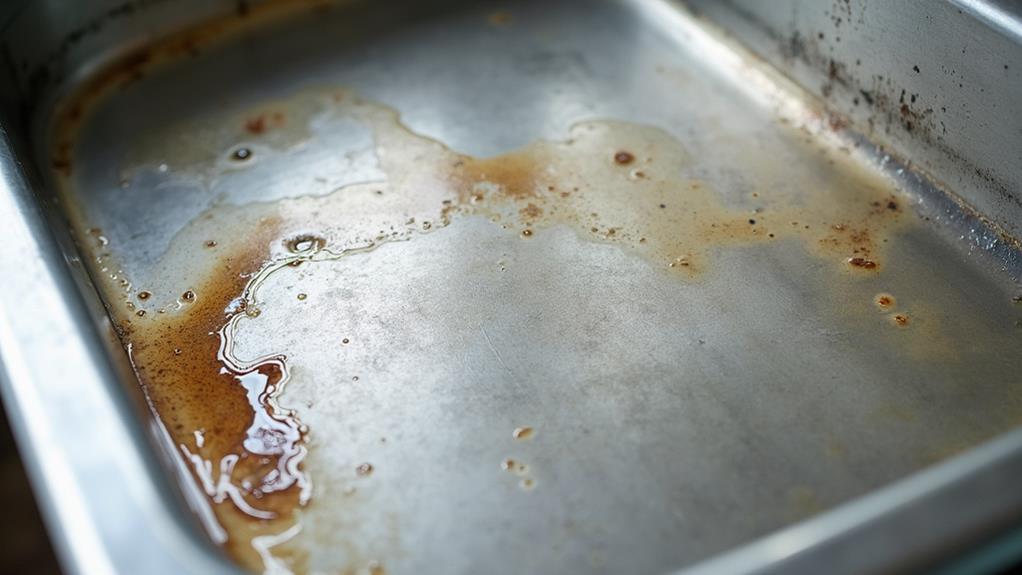
One of the biggest mistakes you can make with stainless steel care is letting spills sit. When spills are left unattended, they can lead to staining, corrosion, and even permanent damage. Implementing effective spill prevention and cleaning techniques is essential to maintaining that sleek, polished look.
To avoid issues, follow these steps:
- Act Quickly: As soon as you notice a spill, wipe it up immediately. This prevents liquids and residues from bonding with the steel surface.
- Use the Right Cloth: Opt for a soft microfiber cloth. Harsh materials can scratch the surface, making it more susceptible to future spills and stains.
- Employ Proper Cleaners: Use mild, non-abrasive cleaning solutions. Avoid bleach or chlorine-based cleaners, as they can cause discoloration and damage.
- Rinse and Dry: After cleaning, make sure to thoroughly rinse the area with clean water and dry it completely. This guarantees no residue is left behind to cause future problems.
Using Hard Water
Dealing with hard water can complicate stainless steel care. When you use water with high mineral content, it leaves behind unsightly spots and streaks. The water hardness effects can dull your stainless steel's shiny surface over time, making it look worn and neglected. If you notice white, chalky deposits, that's a clear sign of mineral buildup.
To prevent this, you need to be proactive. Initially, consider installing a water softener. This device reduces the minerals in your water, minimizing buildup on your stainless steel appliances. Using distilled or filtered water for cleaning can also make a big difference.
Following washing or rinsing with hard water, always dry the surface immediately with a soft cloth. Leaving it wet allows minerals to settle and form deposits. Furthermore, regular maintenance is key. Wipe down your stainless steel with a mixture of vinegar and water to dissolve any mineral residue. Using a stainless steel cleaner specifically designed to tackle hard water spots can also be effective.
Skipping Regular Cleaning
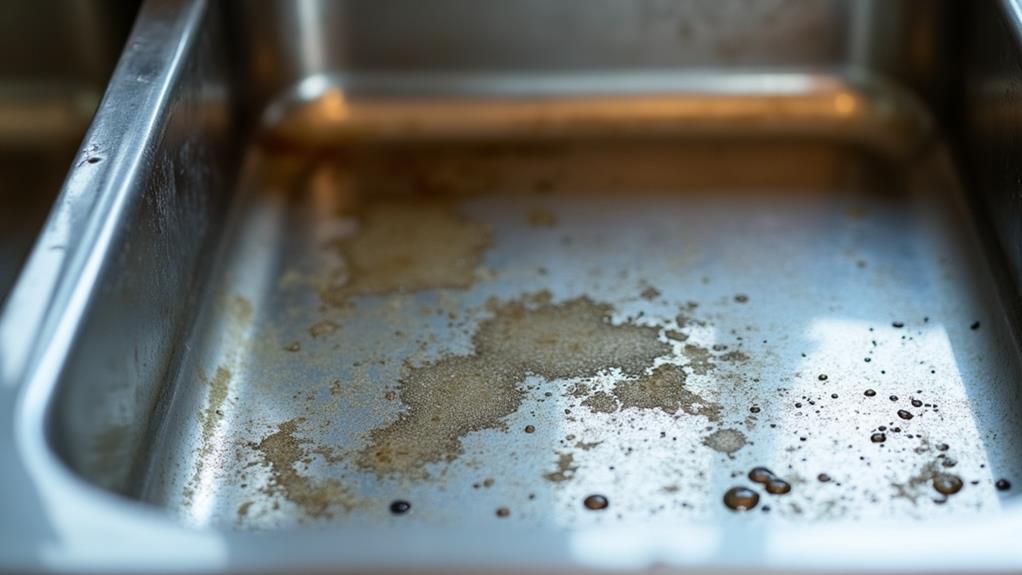
Neglecting regular cleaning can quickly turn your stainless steel surfaces into a breeding ground for grime and bacteria. It's vital to stay on top of stainless maintenance to keep your kitchen and appliances looking pristine. Skipping out on this significant task can lead to unsightly stains and even compromise the material's durability.
Here's why regular cleaning and routine inspection are fundamental:
- Prevents Corrosion: Even though stainless steel is resistant to rust, it's not completely immune. Regular cleaning removes corrosive substances that can damage your surfaces.
- Maintains Shine: Dirt and fingerprints dull the natural shine of stainless steel. A consistent cleaning regimen keeps it sparkling and looking new.
- Hygiene: Stainless steel surfaces in kitchens and bathrooms can harbor bacteria if not cleaned frequently. Routine cleaning guarantees these areas remain sanitary.
- Prolongs Lifespan: Regular maintenance helps you catch potential issues early, allowing you to address them before they become major problems.
Make it a habit to clean your stainless steel surfaces weekly, if not daily. A simple wipe-down with a damp cloth followed by drying with a soft towel can make a significant difference. Regular attention to your stainless steel guarantees it remains a durable and attractive feature in your home.
Ignoring Manufacturer Guidelines
While regular cleaning is key to maintaining stainless steel, it's likewise vital not to overlook the manufacturer's guidelines. These guidelines provide significant information tailored to the specific type of stainless steel you own. Ignoring them can lead to unintended damage or reduced lifespan for your appliances.
Manufacturer recommendations often include details on product compatibility, highlighting which cleaning agents and methods are safe to use. For instance, some stainless steel products might be sensitive to certain abrasive cleaners or require a specific type of polish. Failing to follow these instructions can result in unsightly scratches, discoloration, or even corrosion.
Moreover, manufacturers understand the unique properties of the materials they've used. They test and approve cleaning products that won't compromise the integrity of your stainless steel. By adhering to these guidelines, you're ensuring that your cleaning efforts are both effective and safe.
Don't underestimate the significance of these recommendations. They're not just suggestions; they're based on extensive research and testing. So, before you reach for that all-purpose cleaner or abrasive scrubber, take a moment to review the manufacturer's instructions. It'll save you time, money, and the headache of dealing with avoidable damage.

